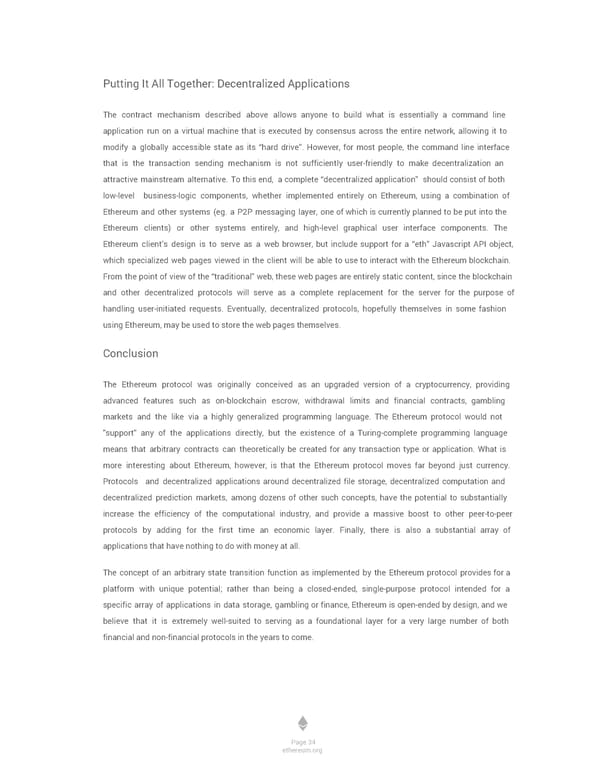Putting It All Together: Decentralized Applications The contract mechanism described above allows anyone to build what is essentially a command line application run on a virtual machine that is executed by consensus across the entire network, allowing it to modify a globally accessible state as its “hard drive”. However, for most people, the command line interface that is the transaction sending mechanism is not sufficiently user-friendly to make decentralization an attractive mainstream alternative. To this end, a complete “decentralized application” should consist of both low-level business-logic components, whether implemented entirely on Ethereum, using a combination of Ethereum and other systems (eg. a P2P messaging layer, one of which is currently planned to be put into the Ethereum clients) or other systems entirely, and high-level graphical user interface components. The Ethereum client’s design is to serve as a web browser, but include support for a “eth” Javascript API object, which specialized web pages viewed in the client will be able to use to interact with the Ethereum blockchain. From the point of view of the “traditional” web, these web pages are entirely static content, since the blockchain and other decentralized protocols will serve as a complete replacement for the server for the purpose of handling user-initiated requests. Eventually, decentralized protocols, hopefully themselves in some fashion using Ethereum, may be used to store the web pages themselves. Conclusion The Ethereum protocol was originally conceived as an upgraded version of a cryptocurrency, providing advanced features such as on-blockchain escrow, withdrawal limits and financial contracts, gambling markets and the like via a highly generalized programming language. The Ethereum protocol would not "support" any of the applications directly, but the existence of a Turing-complete programming language means that arbitrary contracts can theoretically be created for any transaction type or application. What is more interesting about Ethereum, however, is that the Ethereum protocol moves far beyond just currency. Protocols and decentralized applications around decentralized file storage, decentralized computation and decentralized prediction markets, among dozens of other such concepts, have the potential to substantially increase the efficiency of the computational industry, and provide a massive boost to other peer-to-peer protocols by adding for the first time an economic layer. Finally, there is also a substantial array of applications that have nothing to do with money at all. The concept of an arbitrary state transition function as implemented by the Ethereum protocol provides for a platform with unique potential; rather than being a closed-ended, single-purpose protocol intended for a specific array of applications in data storage, gambling or finance, Ethereum is open-ended by design, and we believe that it is extremely well-suited to serving as a foundational layer for a very large number of both financial and non-financial protocols in the years to come. Page 34 ethereum.org
 Ethereum White Paper by Vitalik Buterin Page 38 Page 40
Ethereum White Paper by Vitalik Buterin Page 38 Page 40